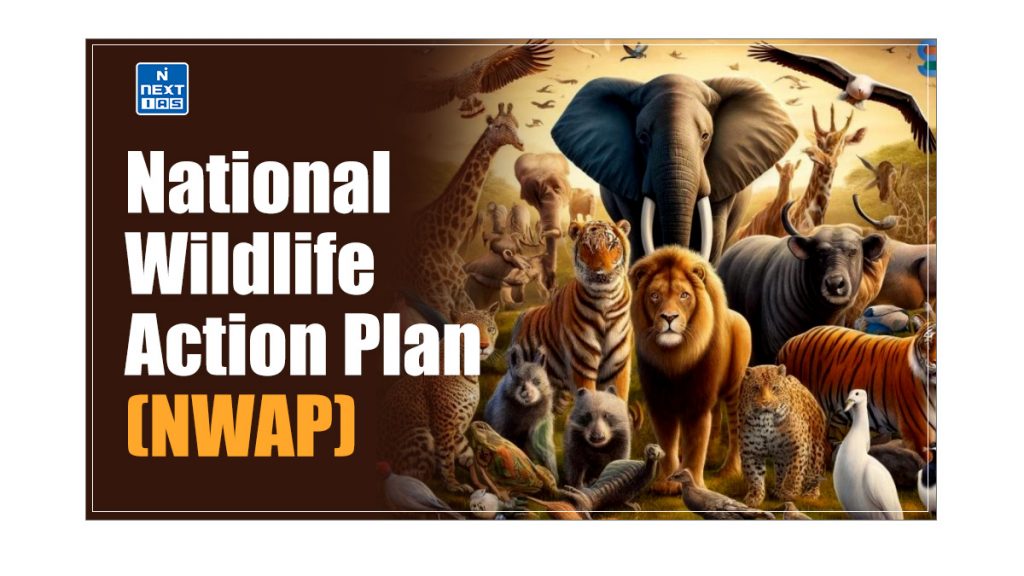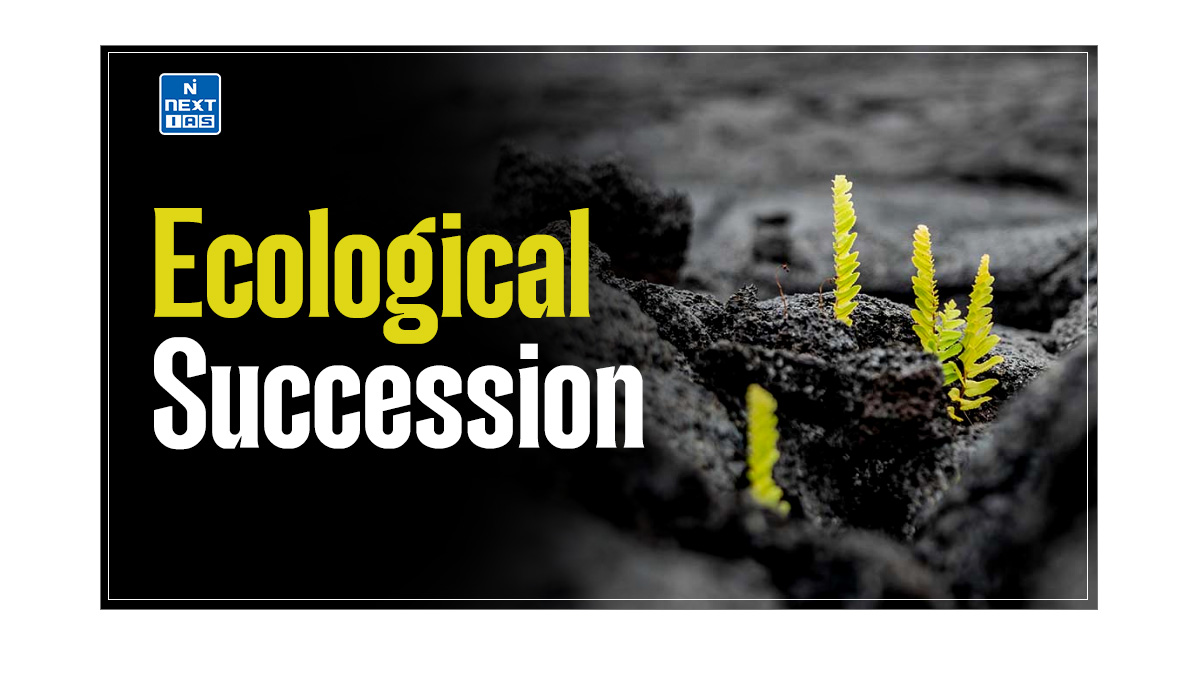
The National Wildlife Action Plan (NWAP) represents India’s commitment to ensure the conservation of its wildlife. It has played a pivotal role in ensuring the dual goal of protecting the country’s wildlife and ensuring sustainable development. This article aims to study in detail the National Wildlife Action Plan (NWAP), its background, evolution, key provisions, challenges and other related aspects.
About National Wildlife Action Plan (NWAP)
- The National Wildlife Action Plan (NWAP) is a policy framework formulated by the Government of India to address the conservation needs of the country’s diverse wildlife.
- It was first introduced in 1983 and subsequently updated in the later years.
- It outlines strategic actions and priorities for the protection and management of wildlife and their habitats.
- The plan aligns with India’s broader environmental and biodiversity goals and adheres to international conventions on wildlife conservation.
Background and Evolution of National Wildlife Action Plan
- A road map to conserve the wildlife of the country, in the form of an Action Plan, was mooted in the XV meeting of the Indian Board for Wildlife (NBWL) in 1982.
- Accordingly, a plan was prepared and launched in 1983.
- The plan evolved over time based on the learnings and emerging challenges.
- Till now, three phases of the National Wildlife Action Plan (NWAP) have been launched.
First Phase of National Wildlife Action Plan (NWAP)
The first phase of the National Wildlife Action Plan was launched in 1983 and lasted from 1983 to 2001.
Second Phase of National Wildlife Action Plan (NWAP)
- On the completion of the first phase of NAWP and based on the new concerns and challenges, the plan was revised, and the second phase lasted from 2002-16.
- The challenges which necessitated a revision of the first phase of the plan and the launch of the second phase of the plan include:
- increased commercial use of natural resources,
- growth in human and livestock populations,
- changes in the consumption patterns,
- rising interest in biodiversity conservation. Etc
Third Phase of National Wildlife Action Plan (NWAP)
- Based on the second phase’s evaluations and lessons learnt, the plan’s third phase has recently been launched.
- The period of operation of the third phase of the National Wildlife Action Plan (NWAP) is 2017-31.
Strategies of National Wildlife Action Plan (NWAP)
The National Wildlife Action Plan has three strategies:
- Maintenance of the ecosystems
- Preservation of genetic diversity
- Sustainable utilisation of species and ecosystems
National Wildlife Action Plan 2002-2016 (NWAP 2002-2016)
- The Government of India, with technical support from research organisations, initiated several actions towards the conservation of threatened species of fauna, including status survey of highly threatened species such as Tibetan Antelope, Wild Yak, Hangul, Brow-antler Deer or Sangai, Wild Buffalo, Gangetic Dolphin, Lesser Florican, Bengal Florican, Great Indian Bustard, Nicobar Megapode, Dugong, Sea Turtles, and other coastal and marine species.
Read our detailed article on Project Dolphin.
- Also, Species recovery plans have been prepared for various terrestrial and aquatic species.
- Conservation breeding projects for threatened species such as vultures and pigmy hog have been implemented successfully in the country.
- Technical expertises for capture, translocation, and rehabilitation of large mammals including carnivores, gaur, rhinoceros and elephants have been developed.
- A special programme has been initiated for the reintroduction of the Asiatic Cheetah in its original habitat in Western India under the supervision of a technical committee, which supervised the identification of sites for reintroduction, identification of the source population, captive breeding and soft release.
- Central Zoo Authority (CZA) listed as many as 73 species of fauna for conservation breeding, of which 26 have been listed as priority species and guidelines have been developed for their captive breeding.
- However, Conservation of threatened species of flora, especially local endemics and highly traded species such as medicinal plants and orchids, has received relatively less attention so far.
- MoEFCC, with the support from UNDP and GEF, has recently completed a project on the conservation of globally threatened medicinal plants in three states of India viz., Uttarakhand, Chhattisgarh and Arunachal Pradesh.
- One of the outcomes of this project has been the establishment of several Medicinal Plant Conservation Areas (MPCAs) in these states.
- A concept of medicinal plant development area (MPDA) has been given for ex-situ conservation of such species.
National Wildlife Action Plan 2017-2031 (NWAP 2017-2031)
- The MoEFCC has initiated a new Centrally Sponsored Scheme: Integrated Development of Wildlife Habitat (IDWH) for assisting the State Governments in protection of wildlife and its habitats outside Protected Areas.
- The State Governments are encouraged to identify habitats for highly threatened species of flora and fauna outside the PAs and submit proposals for their management and long term monitoring.
- This would include conservation and long term monitoring of such habitat.
- Salient Features of the third phase of the National Wildlife Action Plan 2017-2031 (NWAP 2017-2031) are as follows:
- Strengthen and Improve the Protected Area Network: The plan aims to strengthen and improve the protected area network of the country.
- Presently, the country has a total of 726 PAs, covering 1.60 lakh sq km i.e. 4.88 percent of the geographical area.
- Strengthen and Improve the Protected Area Network: The plan aims to strengthen and improve the protected area network of the country.
Read our detailed article on Protected Area Network (PAN) in India.
- Landscape Level Approach for Wildlife Conservation: There are large numbers of wildlife occurring outside PAs also. Therefore, challenges of limited land (habitats), human pressures and development must all be kept in mind before preparing plans for the conservation of these wildlife and their habitats.
- Rehabilitation of Threatened Species: Many species face danger of extinction and are vulnerable due to over-exploitation, habitat degradation and loss. Many of these have become extinct now. Such species, especially endangered and critically endangered, need immediate conservation measures by way of conducting status surveys, preparation of recovery plans, and identification and protection of critical habitats.
- Conservation of Inland Aquatic Ecosystems: It will be done through steps that include maintenance of wetlands by way of assuring ecological flow so that their water requirement is properly met.
- Conservation of Coastal and Marine Ecosystems: This includes fragile ecosystems like Coral reefs, Mangroves, Seagrass meadows, Salt marshes, Sand dunes, Coastal wetlands among others.
- Integration of Climate Change in Wildlife Planning: As Climate change is expected to make major impacts on global biodiversity through drivers such as emission of carbon dioxide, fertilization of plants, latitudinal and altitudinal shifts in species distributions, and altered community interactions, wildlife planning needs to be integrated with conservation plans.
- Control of Poaching and Illegal Trade in Wildlife: Poaching and illegal trade has emerged as one of the most serious threats to wildlife. Wildlife trade remains one of the five top illicit economic activities globally.
- Improving the Health of the Wildlife: Many emerging infectious diseases have affected wildlife adversely. Recent emergence of the tiger as a new host for Canine Distemper, geographic spread of Endotheliotropic Herpes Virus (EEHV) among elephants and reports of goat pox in goat-antelopes of the North-Eastern India only reiterate the need for urgent measures for protecting the Indian wildlife against diseases.
- Mitigating Human-Wildlife Conflicts: As these have been increasing at local and regional scales in India in recent decades. Such conflicts include loss of cultivated crops, livestock, and property such as houses, transmission of diseases by wildlife to people and livestock, and loss of human lives both indirectly and directly.
- Management of Tourism in Wildlife Areas: In recent years, Mushrooming of tourist visitation and tourist facilities has led to overuse, disturbance and serious management problems for managers in a number of PAs.
- People’s Participation in Wildlife Conservation: It is learnt from the past experiences of exclusionary models of forest and wildlife management that it made the local people hostile towards the State Forest Departments (SFDs) and impacted negatively on conservation efforts.
- Strengthening Research and Monitoring: With the reduction and fragmentation of natural habitats resulting in increased stress on ecosystems and plant and animal populations, there is an urgent need for formulating conservation strategies and management plans for the target species and PAs backed by sound scientific research.
- Improving compliance with Domestic Legislations and International Conventions: Integration of important international conventions, such as CITES, CMS, CBD, Ramsar, etc., with the existing Indian wildlife and environmental Laws is required in order to provide a clear and comprehensive way for not only conservation of wildlife but also protection and regulations related to sustainable management and use.
Read our detailed article on Environmental Laws in India.
- Ensuring Sustained Funding for Wildlife Sector: Conservation action in general and protected area management, in particular, has been facing far less financial support than required in terms of the needs of the country as envisaged in the global commitments on conservation and management requirements for sustainability of the forest resources.
- Integrate NWAP with Other Sectoral Programmes: With India having multiple governance frameworks and structures that administer the various ecosystems including coastal and marine, it is important to integrate wildlife plans with other sectoral programme.
- Overlapping jurisdictions, contradictory mandates and limited coordination hinders multiple agencies from working effectively in managing wildlife and their habitats in India.
Conclusion
The National Wildlife Action Plan (NWAP) represents a comprehensive and evolving strategy for wildlife conservation in India. By addressing key conservation challenges and integrating a range of actions and priorities, the NWAP aims to protect the country’s rich biodiversity and ensure the sustainable management of its natural resources. Continued commitment, collaboration, and innovation are essential to achieving the goals of the NWAP and securing a future where India’s wildlife thrives alongside human development.
Frequently Asked Questions (FAQs)
What does NWAP stand for?
NWAP stands for National Wildlife Action Plan.
Which ministry has launched the National wildlife Action Plan?
It has been launched by the Union Ministry of Environment and Forests.
What is the purpose of India’s National Wildlife Action Plan?
The main purpose of India’s National Wildlife Action Plan is to ensure protection and management of wildlife and their habitats.
Why is National Wildlife Day celebrated?
National Wildlife Day is celebrated every year on 4th September to raise awareness about the value of protecting endangered species worldwide and conserving wildlife.






